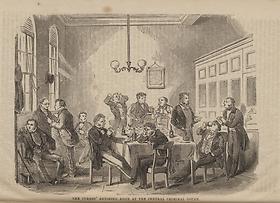Cases
Toxicology in the dock: Alfred Swaine Taylor and the William Palmer murder trial
The new science of toxicology was tested and found wanting in one of the most controversial murder trials of mid-Victorian England, the case of William Palmer.
On November 14, 1855, John Parsons Cook, a 28-year-old gambler and horse-owner, fell ill and went into convulsions while celebrating his horse's victory and £3000 in winnings. Surgeon William Palmer, a fellow gambler and horse-owner, immediately took charge of the young man's medical treatment. After suffering a week of excruciating pain, Cook died—though not before he accused Palmer of poisoning him.
The incident was one of a long series of deaths due to sudden illness with which Palmer was connected. A few months earlier, Palmer's wife Ann and middle-aged brother both died—after the surgeon had taken out large insurance policies on them. Before that, Palmer's mother-in-law, most of his children, his uncle, and four or five other people had also suddenly taken ill and died. These deaths—along with the fact that Palmer was deeply in debt, pressed by creditors, and holding Cook's prize money—aroused the suspicion of Cook's father-in-law, who requested that Cook's body be exhumed and examined.
The autopsy was performed by a team of local medical men, with Palmer present as a colleague not a suspect. During the examination, Palmer was said to have tampered with a key piece of evidence—the contents of Cook's stomach—by bumping into one of the physicians as he was lifting out the stomach, causing the contents to spill. The remaining material was placed in a sealed jar, but Palmer was also suspected of slitting open the seal.
The coroner consulted Dr. Alfred Swaine Taylor, who tested Cook's stomach and the small remaining sample of stomach contents. The results showed only a small, non-lethal amount of antimony, the active ingredient of tartar emetic, a common medicine. But on the basis of reported symptoms and circumstances prior to death, Taylor concluded that Cook had been poisoned by strychnine. Palmer was indicted for Cook's murder.
The trial lasted 12 days. Taylor was called as a witness. Renowned as a great authority on forensic medicine, Taylor had made grand claims for toxicology in his textbooks.
"Probably there is no branch of medicine in which we meet with a larger assemblage of truths ascertained by observation….To the physician, the pathologist, and the medical jurist, a knowledge of [toxicology] is of great importance…in drawing a clear distinction between changes produced in the body by disease and those caused by poison, [and]…in detecting and punishing those…guilty of the crime of poisoning."
—Alfred Swaine Taylor, M.D., English toxicologist, 1848
The defense's strategy was to put Taylor's expertise, and toxicology itself, on trial. Palmer's lawyers showed that Taylor had no direct knowledge of the effects of strychnine on humans, having only observed the effects of strychnine on ten rabbits in an experiment performed more than twenty years earlier. They put opposing experts on the stand who contradicted Taylor, and they claimed that Taylor, who had a haughty demeanor on the witness stand, was biased and made prejudicial statements to the press.
The prosecution countered that Palmer's tampering rendered thorough chemical analysis impossible, and that Cook's poisoning was particularly hard to analyze because Palmer's medical expertise made him an exceptionally crafty poisoner, capable of murdering with minimal doses of strychnine, a hard-to-trace, organic poison, which is lethal in small doses and decomposes over time.
The jury agreed. Palmer was found guilty and sentenced to be hanged. But his last words were "I am innocent of poisoning Cook by strychnine." The decision—and Taylor's claims for forensic toxicology—remained controversial. Taylor was besieged by public criticism and ridicule, but, over the years, he maintained his standing as an eminent authority. In the 1859 edition of On Poisons, in Relation to Medical Jurisprudence and Medicine, he devoted many pages to justifying his actions in the Palmer trial. As years passed and public memory of the case faded, he omitted mention of it in later editions.
